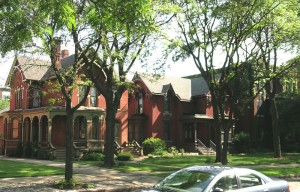Part II: How to Stop Digging the Legacy City Hole Deeper

By The Economic Development Curmudgeon
A few weeks ago we published Part I of our commentary on the Lincoln Institute of Land Policy report, Regenerating America’s Legacy Cities by Alan Mallach and Lavea Brachman. To refresh the reader, the Lincoln Institute report defines and identifies eighteen “legacy cities” as central cities with a minimum population of 50,000 (2010) who have suffered more than a twenty per cent loss in peak population. These cities are Akron, Baltimore, Birmingham, Buffalo, Camden, Canton, Cincinnati, Cleveland, Dayton, Detroit, Flint, Milwaukee, Newark, Philadelphia, Pittsburgh, St. Louis, Syracuse and Youngstown. Each legacy city was ranked on fifteen indicators, Based on these variables, they constructed an index and ranking order from which the top three cities were: Philadelphia, Pittsburgh and Baltimore; and the bottom three cities were: Flint, Detroit, and Youngstown (see Table 3, p. 20 of the actual report). The indicators and the rankings guided the analysis of the Lincoln Institute report and informed its conclusions. But, the crux of the report is based more on its prescriptions and theoretical framework of the authors rather than drawn from the index and its rankings.
Part I discussed our assessment of the contents and framework of the Lincoln Institute Report. For the reader who has not yet taken a gander at that issue, we found several outstanding contributions worth the reader’s attention, but we also identified a few, frankly serious, concerns with the policy perspective and policy prescriptions included in the report. Because we wanted to discuss these issues more deeply, and also to better present our sense of how a legacy city can stop digging its legacy hole deeper, we decided to construct Part II which would be devoted to these more serious concerns and our policy prescription for legacy city revitalization. If the reader wants to first understand the report itself, we refer the reader to Part I.
Finally, we note that one excellent reason to read the Lincoln Institute Report is that, in our opinion, it is the best commentary in recent years which reflects the “conventional wisdom” of the profession and academia concerning the causes and the policy prescriptions relevant to legacy city revitalization. The Lincoln Institute Report is a “mainstream”, dare we say paradigmatic, presentation of how legacy cities dug (or got dug by others) their present hole of a seemingly bottomless economic, social, fiscal, and political decline. Detroit is the cutting edge of this decline, but by no means is it alone out there on the precipice. Our concern is that conventional wisdom includes a couple of serious miss-directions which essentially, in the minds of critically important constituencies, creates an image that the legacy city is still digging its hole deeper–or worse, is defining legacy city success/revitalization in a zero-sum manner, thereby alienating essential partners to their revitalization effort.
The Centrality of a Particular Form of Regionalism to Legacy City Revitalization
Interwoven throughout the Lincoln Institute Report, and central to many previous articles and books reflecting the legacy city conventional wisdom on legacy city revitalization is the key, indeed, essential role of regionalism. The Curmudgeon does not think he is exaggerating when he assets that for the conventional wisdom regionalism is the core policy solution to legacy city revitalization. Also, as explained in Part I, suburbanization is the prime cause of legacy central city decline. Suburbs captured former residents of the central city, fragmented the metropolitan policy-making process, attracted manufacturing and other jobs, and garnered control over important regional functions which formerly were controlled by the central city. 
According to the conventional wisdom, suburbs left the central city as a hollowed out shell, a demographic and social dumping ground without sufficient resources and governance capacity to sustain effective service delivery. Additionally, it left them unable to pay for the services needed by their disproportionately distressed residential population (legacy costs). Not surprisingly, central legacy cities are peering over a fiscal cliff, trying to pay off their legacy costs almost by themselves. Enter regionalism!
Regionalism becomes a necessary element to a successful legacy city revitalization; its function is to overcome the “legacy” that the suburbs left behind. We have no problem with THAT. But just what do we mean by regionalism and, more importantly, what does conventional wisdom and the Lincoln Institute Report mean by regionalism? Essentially, our fear is that the definition of regionalism articulated by the conventional wisdom and Lincoln Institute Report is harmful to any potential legacy city revitalization strategy. We think it makes legacy city revitalization unlikely, and worse, it turns potential allies and partners into opponents or at least bystanders. In the below sections we make our case.
A Particular Kind of Regionalism: What is this “functions and social equity stuff”?
The Lincoln Institute embraces a complicated perspective on regionalism. Unspoken and seldom made obvious, the conventional wisdom asserts a primacy of central city over the suburbs and assumes as natural that the central legacy city should be the preferred location for residency and industry. Legacy cities have had their “functions” torn from them, mostly by the suburbs and the goal seems to be to get suburbs back into central city control. Indeed, the “legacy” of legacy cities is that all that remains of their historical and functional greatness is a memory, the legacy of what they once were.
“The way they were” is chiefly drawn from their “golden years” or peak years of population and jobs. During these legacy years the central city occupied the primary (we prefer hegemonic) position in its metropolitan hierarchy of cities. This hegemonic position is described in statements by the Lincoln Institute Report such as:
In their heyday, legacy cities were hubs of business, retail, and services for their regions, which often encompassed hundreds of square miles around the city. While factories provided the greatest number of jobs, the downtown areas contained department stores, professional offices and financial institutions that served the entire region”. (p.4)
This natural and desirable regional hegemony, however, was disturbed by:
Municipal fragmentation [in the Curmudgeon’s opinion a code word for suburbanization], economic and racial conflicts, and dependence on local property taxes created a climate in which regional considerations were given low priority, fostered exclusionary zoning and pushed growth to the periphery. In slow-growing areas suburban development cannibalized central cities and inner-ring suburbs, further undermining their vitality” (p.6) and “State governments must bear much responsibility for the fragmentation of local government, the dysfunctional systems of financing [?] local government, and the absence of larger regional frameworks”. (p. 7)
In our words the report is saying these disruptive forces and negative dynamics screwed up this natural order of central city primacy over the metropolitan “hinterland”. During these golden years the central city performed the key, critical functions associated with metropolitan growth and prosperity. The logic of any current legacy city revitalization initiative, drawn from this conventional wisdom, asserts that the hegemonic position of the central legacy city should be restored to the greatest extent possible.
The loss of central retail and service functions paralleled the loss of manufacturing. Department stores closed or moved to the suburbs, while one after another locally owned banks were absorbed by anonymous global institutions. Today the only central functions that remain in many legacy city downtowns are those of city and county government, along with a growing social service sector. (p.4)
To accomplish this function-restoration task, however, we need to find the hidden list of all these lost metropolitan “functions”, so that we can evaluate what functions went where. This is pretty fuzzy ground in that we wonder if over the years various scholars and commentators have more or less invented functions as they went along. Central city primacy based on “functional performance” is a pretty fuzzy, or shall we say, flexible foundation. We don’t think foundations should be all that flexible; and why can’t functions evolve as everything else must evolve? Figuring out how to relocate this fuzzy assemblage of time-honored functions back into the central city doesn’t sound like a particularly attractive agenda to drum up allies, partners and resources in the revitalization initiative. Once one leaves the classroom or think tank there is little to no consensus that any particular function exists at all. Restoring downtown retail by relocating suburban malls to the CBD, for example, seems a bit much for any mayor or governor to embrace. For most, the Curmudgeon would wager, this retail train has long left the station. We suspect that might be true of any functions that conventional wisdom wants returned to the central legacy city. One wonders if one should give up on the “functions stuff” and move on. For better or worse, our contemporary urban areas are, more or less, multi-nodal and let’s deal with it!
Legacy Costs and Social Equity
Our concern with regionalism is further intensified when we next wander into why the Lincoln Institute report believes regional involvement is necessary. They believe local government costs in legacy cities are increasing faster than population growth (duh–they have lost about half of their peak population), driven by rising infrastructure-related expenditures, and pension costs–also referred to as legacy costs–while revenue sources decrease. (p. 14) The Curmudgeon cannot see the suburban and hinterland voters, and their suburban state representatives joyfully lining up to vote in favor of increased taxes and state bailouts of unfunded central city pension and healthcare liabilities, and for perceived ineffective (arguably overwhelmed) bureaucracies. To us they will never join in a central city revitalization effort if they believe that their money and effort will not be wasted or abused.
Like it or not, if central city advocates want legacy costs to be addressed, they had better first prove to the suburbanites that the central city is not a bottomless pit. What’s more they need to distinguish legacy costs which are shared with the suburbs (area-wide infrastructure and shared regional services such as museums and cultural institutions) and those legacy costs which the legacy city itself incurred. In the current environment, pension and health benefit costs are especially vulnerable. We will argue shortly that before any redefined regionalism will be successful, the legacy city must resolve the pension and health care costs. This is the first step in not digging the legacy hole deeper.
On top of legacy costs The Lincoln Report asserts that “social equity is yet another critical consideration in regeneration and plans MUST [our emphasis] be put in place to ensure that lower income and minority residents benefit from rising demand and economic growth.” (p. 3). What is this social equity stuff? It seems to us there are two levels of social equity built into the conventional wisdom. The first notion behind suburban-legacy city social equity is that the legacy city in earlier periods of time supported, if not subsidized, institutions, services, infrastructure and what have you for the entire metropolitan region. Now it is payback time. The legacy city needs help and the suburbs should step up to the plate. This notion is conflicted if the legacy city is as a first order priority trying to reassert its primacy over the region. Until we jettison this “functions” element of legacy city revitalization, the legacy city is vulnerable to the all-too-reasonable counter that if the legacy city wants functional leadership, it had best be willing to pay for it. This notion of social equity is a non-starter. Legacy city “glory days” matter not in any metropolitan area’s future.
The second level of social equity is much tougher and that is the level on which the Lincoln Report concentrates. The obvious reality is that most legacy cities are baskets of poverty, have the most one head of households, the least educated, the most unemployed, the most deteriorated housing and neighborhoods, and are disproportionately composed of racial minorities. These are truly the region’s hard luck areas and those who are more affluent and successful ought morally to step to the plate and help. Having said this, no one, least of all the Lincoln Report, frames this level of social equity in terms of moral obligation. Rather, the argument advanced is that these concentrations of poor and disadvantage impose costs of the affluent regions and it is in the self-interest of the affluent regions to address these geographies of desperation. The Lincoln Report, for example, asserts “that these regions [the suburbs] will need to address such issues [associated with the clusters of poverty/deterioration] in order to sustain economic vibrancy” (p.16). This “economic sustainability” argument, however, is an attempt to appeal to rational self-interest, because pure morality won’t play to the suburbs.
It is essential to address equity issues in order to promote sustainable business and economic growth; ignoring them is ultimately counterproductive for economic expansion. Regions cannot rely solely on recruiting talent from outside the area. Social and economic costs are associated with high levels of inequality and poverty. Additionally, under-and unemployment reduce regional growth…. Regional solutions must be engineered to compensate when inequality on a variety of economic indicators (such as income and business creation) acts as a drag on growth. (pp. 16-17)
At some level these assertions may be correct–but most folk don’t climb to that level. Maybe a certain kind of political leader can articulate the rhetoric that can forge the degree of understanding and compassion among suburbanites to make this argument persuasive, but from our perspective it is one more “moving part” that can divide as much as its motivates. From the perspective of conventional wisdom, the addition of social equity means that it is not sufficient to simply drop another economic engine into the central city economy–that engine must produce social and economic justice. Those so inclined may feel better to link social equity into a legacy city revitalization package, but, the Curmudgeon believes that social equity is “one bridge too far”.
Suburban Reaction to “This Particular Form of Regionalism”: First Step in Stopping Digging the Hole Deeper!
Backing up a bit, the Curmudgeon believes that the politics of regionalism as defined by the conventional wisdom creates an impossible burden upon legacy city revitalization–especially when regionalism is equated with central city hegemony, suburbs responsible for central city legacy costs and a perceived need to address social equity issues. Why? Because the average suburbanite will perceive this form of regionalism as an unwanted and unwelcome relationship with the central city and will to some degree resist what they regard as an unfair and invasive intrusion into their wallet and fiscal independence–not to mention their residential identity. To say it another way, this form of regionalism will be perceived by suburbanites as a one-sided “sharing of fiscal resources”. Also, equating suburbia as little more than an anti-environmental sprawl puts the conventional wisdom legacy city advocates on the defensive. Someone’s sprawl is someone else’s home. If the suburbs are a vital and necessary part of legacy city revitalization, this is not a way to appeal to their “better angels”.
If this perception of suburban reaction is relatively accurate, why wouldn’t a more effective central city revitalization strategy be to forge helpful, symbiotic relationships and programs with suburbs. Why try to “rein in” perceived suburban competition in business location and attack suburban autonomy by asserting central city functional leadership? Why expect the suburbs and the state to pay for costs and deficits not of their making? Instead why not attract suburban fiscal and economic resources in a voluntary effort of each party to achieve a desired and shared goals for metropolitan prosperity and enhanced quality of life.
Many of the vehicles discussed in the Lincoln Institute Report could serve very well in this differently articulated regionalism component to legacy city revitalization. Everything from intermunicipal service agreements, regional service districts and regional entities are excellent vehicles to address legacy city needs. Consolidation gets more dicey, and its track record supports that observation. Would city-county consolidation be helpful? Of course, but the path to consolidate is complicated, time-consuming and very fragile–and consolidation itself is only the first step to being able to focus attention of legacy “county” needs. Having the county itself step up to the plate and start taking over local functions might be a more acceptable approach. The key to all of these regional solutions is to stress partnership and mutuality and “we are all in the same boat”–not the themes and rhetoric to which conventional wisdom so easily shifts us.
The First Step in Stop Digging
Perhaps then, as we suggested in our earlier article on Detroit, some effective resolution of legacy costs is a precondition to central city revitalization? It doesn’t have to be bankruptcy. but, the most basic first step to central city revitalization is stop digging a deeper hole. Until the perception exists that ship won’t sink and take everybody with it, why will people work together to repair the ship! That’s why the airline steward’s instruction says “In case of emergency, put the oxygen mask on yourself before you help somebody else”. Legacy cities must first bail themselves out and create a perception that the ship is no longer sinking.
There is a genuine criticism or counter to the Curmudgeon’s critique of Lincoln Institute’s regionalism. A number of the regional solutions advocated by the Lincoln Institute Report are endorsed and presented as regionalist solutions by the Report (cost-sharing through metropolitan service districts-public authorities and transfer to county of some services). The issue which separates us from the Lincoln Institute and the legacy city conventional wisdom regionalist solutions is “the packaging” and the rationale behind the purpose of regionalist initiatives. These solutions as a “right-sizing” strategy–allowing the legacy city to adjust and resize to more realistic population levels and fiscal resources. Moreover, we assert that in most legacy city metropolitan areas there exists a multi-nodal hierarchy. City-suburban relationships are not, in our mind, redistributive nor zero-sum. They are true regional partnerships reflecting the interests of all parties.
This fiscal and pension reform is the first, and best start to forging an effective regional partnership with communities and jurisdictions in the metropolitan area. From this various structural reforms can result in “right-sizing” the obligations and responsibilities of the central city. The issues, however, associated with the concentration of poverty and neighborhood deterioration, however, are, without any question more intractable–at the very least they require more time and equally without doubt are the responsibilities of higher levels of government than municipal. To address these issues it would be more than preferable, it would be necessary for the communities of the entire metropolitan area to join together in a common front. This unity of advocacy would be more likely if regionalism were based on partnerships than any effort by the central city to go it alone and attempt to restore its metropolitan leaderships and functional primacy. This shift from hegemony and functional restoration are also other ways in which a legacy city can stop digging the hole deeper.
Optional Reading:
This “Particular Form of Regionalism” and Central Place Theory
What is this natural order, the desirable primacy of a central city over a hinterland upon which conventional wisdom rests? To us the legitimacy of a hegemonic central city best rests on single (mono) node central place theory (dig up your urban geography text book for that one). Suburbs, especially larger diverse suburbs we see in the Western states in particular, do not square very well with single node central place theory. We think it reasonable to wonder if it fits the contemporary Eastern, Great Lakes metropolitan regions as well. We sense that nation-wide the US metropolitan regions have, or are, evolving into a multi-nodal regional hierarchy of cities. To us, the conventional wisdom questions whether this evolution is, or was, a natural movement from one phase of urban development to another. Rather, conventional wisdom strongly suggests it’s a movement caused by pernicious forces. [we think otherwise!]. More critically, the conventional wisdom links the restoration of hegemonic primacy of the central city with its prescriptions for legacy city revitalization. Sometimes, given the stress and centrality of restoring hegemonic central city primary in the conventional wisdom we wonder if its real goal is less legacy city revitalization than the restoration of central city functional primacy in the metropolitan regional hierarchy?
Rather, the Curmudgeon wonders if the single node metropolitan region is (1) as relevant today as it was in the 1950’s, and (2) whether it needs to be “the natural order” governing city-suburban relationships. Indeed, single node metropolitan areas no longer are an exclusive characteristic of the American metropolitan system. Sun Belt city-suburbs are not, in general, carbon copies of their Northeastern and Midwestern counterparts. In the East, central cities, more or less arrived on the scene first and suburbs are their demographic-economic descendants. That may well be more a function of history, a phase, a period of evolution than the natural order of things. Sun Belt central cities and suburbs, again more or less, grew up together and simultaneously. Also, many first and second generation Western suburban residents spent their childhood in Eastern suburbs and directly moved to Western suburbs. Suburban living is a residential choice today. That choice may be a choice which many prefer not to exist–but it does. The contemporary urban landscape has trended for decades in a multi-nodal direction and while it may ebb and flow, we are not going back to the central city golden years. The suburbs are here to stay..
We question this linkage of central city single node metropolitan primacy with legacy city revitalization strategy. We strongly believe that any attempt to restore central city functional primacy will increase the likelihood of failure in returning the central city to some reasonable level of economic and social vigor. To us linking central city revitalization to some form of aggressive regionalism whose core purpose is restoring central city hegemony is, at best, making the revitalization task way more complicated and time consuming than it needs to be. At worst, this concept of regionalism invites suburban counter reaction and outright opposition. Also the linkage distracts central city reformers from more essential tasks more directly related to dealing with serious central city problems. Delinking this form of regionalism from central legacy city revitalization is an significantly important element of our “if you are deep in a hole, the first step to getting out is stop digging deeper”, argument. The very first step in our stop digging strategy is to deemphasize this aggressive conventional wisdom definition of regionalism and substitute a form of regionalism which stress partnership and mutual advantage for the metropolitan region as whole.
Forgetting for the moment the “functions stuff”, there is a larger issue with the conventional wisdom’s definition of regionalism. If the central city is to be the primary place that will drive future metropolitan economy growth and administer/lead/dominate metropolitan social, economic and political life, then suburban-sprawled decentralization must in some way be countered, minimized if not eliminated. This task is, to us, the task left to conventional wisdom “regionalism”. If so, one wonders where the “allies” are in this endeavor–they certainly won’t be the suburbs and suburban state legislators
The term region obscures the complex web of hinterland jurisdictions (school systems, special districts, regional authorities usually within the orbit of state politics, cities, towns, villages, unincorporated areas–and regional governments called counties). Each of these entities enjoy their own governance and exist in a world of picket-fence fiscal federalism. The regional zoo includes a lot of critters that no smart strategist would want to lasso–or be able to lasso. There is a reason why there are few concrete instances of anything approaching a regional government other than a city-county consolidation Linking central city revitalization to this jurisdictional maze of infighting, impotence, theoretical-ideological babble and conflicting political constituencies is, in the Curmudgeon’s opinion, sentencing central city revitalization to a near- certain death.








Comments
Superbly done !
Comment by Alan Pisarski on February 13, 2014 at 11:25 pm
The comments are closed.